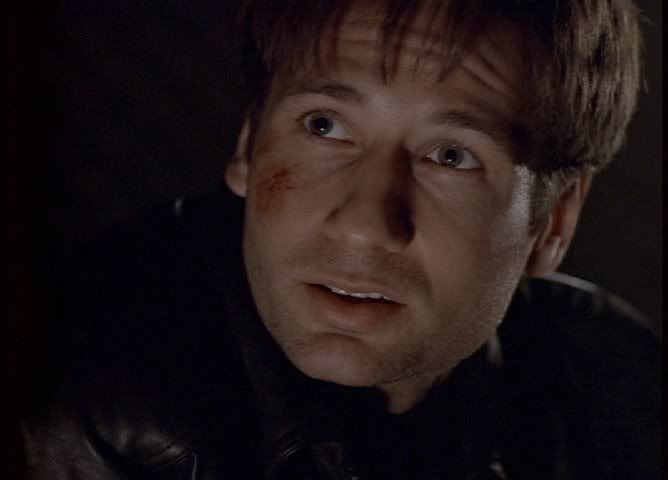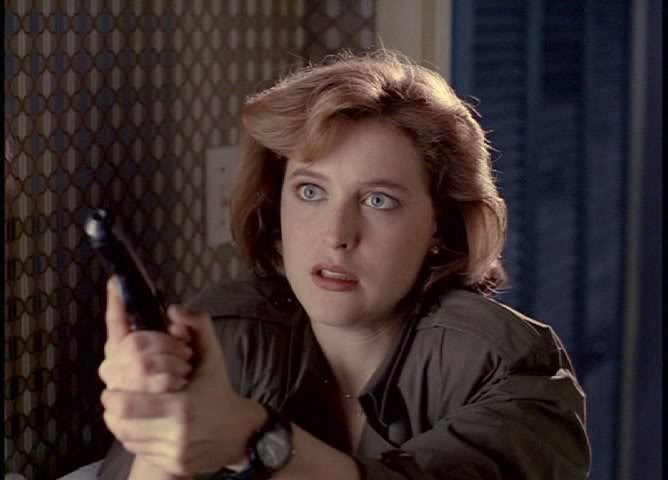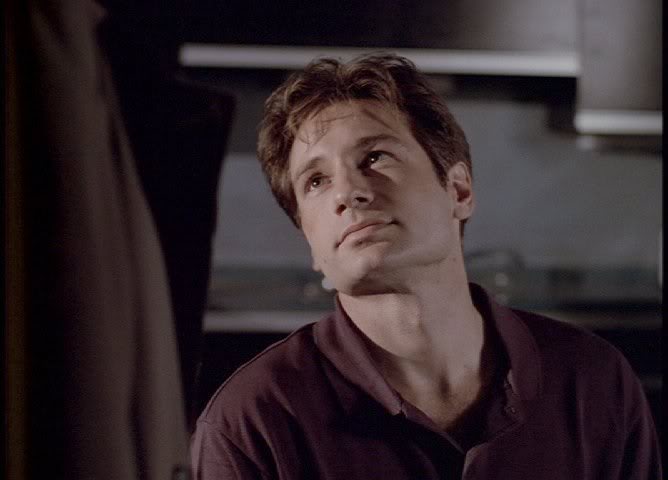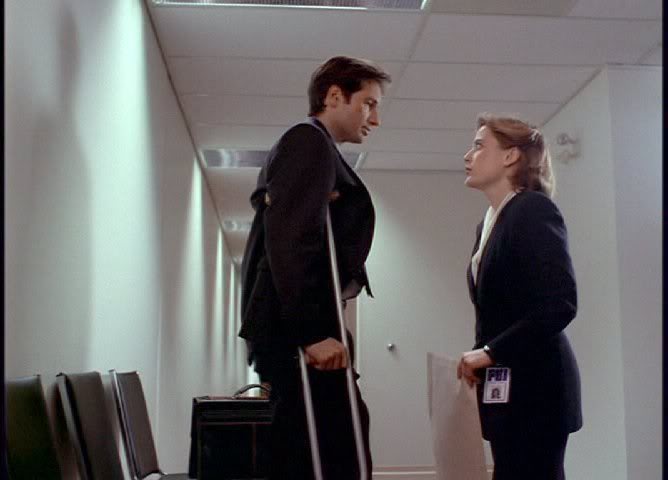CTP Episode of the Day - 11.16.06 - Fallen Angel
Today's Cherished Episode: Fallen Angel (1x09)
Original Air Date: November 19, 1993
Written By: Alex Gansa and Howard Gordon
Directed By: Larry ShawScully and Mulder investigate a possible UFO crash site, which Mulder believes the government is covering up.
"You can deny all the things I've seen. All the things I've discovered. But not for much longer. Because too many others know what's happening out there. And no one. No government agency has jurisdiction over the truth."
Some "Fallen Angel" Tidbits & Musings:
-- Episode title: According to the episode, a "fallen angel" was the code that the military used to describe a downed unidentified flying object (UFO).
-- In a sense, the character of Max Fenig and the NICAP organization represented a sort of precursor to the Lone Gunmen, and the episode also foreshadowed the eventual shutdown of the X-Files at the end of the season, even though the writers "hadn't the slightest clue" that would eventually occur, according to producer and co-writer of this episode Howard Gordon.
-- Gordon said the point of "Fallen Angel" was "to remind the audience what Scully was there for in the first place" -- namely, to act as a skeptic counterbalancing Mulder's devoted belief in the paranormal and, from the Bureau's perspective, to discredit his work where possible.
-- Casting director Lynne Carrow considered Canadian actor Scott Bellis, who played abductee Max Fenig, to be perhaps her proudest "find" in terms of casting the show. Gordon said there was frequently a bias toward casting actors from Los Angeles in lead roles, so when a Vancouver local landed such a part, "you knew they came in and just knocked our socks off," as Bellis did.
-- Scott Bellis said his instructions for playing Max Fenig were to make the audience like the character. "They told me to make him neurotic," Bellis said, "but not in an aggressive way that made him seem dangerous and dark."
-- "We all know this type of guy," said Chris Carter. "Is he a kook -- or a Cassandra?" [Cassandra was a figure in Greek mythology, a prophet. Apollo fell in love with her and granted her the gift of prophecy; however, since she did not love him back, he cursed the gift by having no one believe her prophecies.]
-- "It was an important leap for Mulder and Scully to realize that he might not be crying 'the sky is falling,' that he might be on to something," Carter continued. "Another important element in 'Fallen Angel' was the invisible alien being. I've always believed that what you don't see is scarier than what you do see. And we've always wanted to avoid the 'monster of the week' syndrome. The translucent force field in 'Fallen Angel' is much more malevolent than something that has fangs or a fur coat or a waggly tail. This episode also contained an important narrative element. When Scully came to Mulder and said, 'They're going to shut us down,' the idea that the X-Files project could be terminated from above at any time resonated from that moment forward, a critical part of the narrative tension."
-- Oopsie? The legend at the beginning of the teaser read "Townsend, WI, 12:57 a.m., Day 1," and showed police officers preparing to investigate a crash of something in the woods. After the teaser, when Mulder is shown getting ready to investigate the crash, the legend reads Budgetrest Motel, Townsend, WI, 12:57 a.m. During the scene, flashbacks of Deep Throat giving Mulder information about the crash were shown, and Deep Throat told Mulder he had 24 hours to investigate. The duplicate legend made it appear that Mulder was already in Wisconsin when the crash occurred.
-- As Max told Mulder in the episode, his UFO group NICAP stood for National Investigative Committee of Aerial Phenomena. Max asked Mulder if he was a member of MUFON (Mutual UFO Network) which viewers learned more about in Season 3, CUFOS (the Center for UFO Studies), or CSICOP (Committee for the Scientific Investigation of Claims of the Paranormal). Interestingly, CSICOP encourages the critical investigation of paranormal and fringe-science claims from a responsible, scientific point of view and disseminates factual information about the results of such inquiries to the scientific community and the public. (Sounds like the perfect organization for Scully).
-- Visual effects producer Mat Beck recalled that one of the funniest sequences the crew ever had to work with on the show was in "Fallen Angel," which included a monster that could not be seen (Carter's invisible alien being mentioned above). "We said, okay, if it's in a green forest, let's put that person in an orange suit and I'll be able to extract that person and put in something that's kind of mysterious," Beck recalled. "It was supposed to be this kind of lithe, dangerous, raptor-like creature, and it ended up being a dancer in this bright orange body sock contraption, wearing finds and a hump on her back."
-- "The film that we got back, on the day they shot this rubber-suited thing, was so funny," said producer Paul Rabwin. "I could hear laughter coming from different screening rooms all across the lot." The orange rubber monster can be seen in the Season 1 gag reel.
-- "'The Last Detail' starring Dana Scully." The Last Detail was a 1973 movie starring Jack Nicholson, Otis Young, and Randy Quaid. The film told the story of two U.S. Navy shore patrol policemen who decided to take out a young sailor for one last night on the town before he had to go to jail for eight years.
-- "Fallen Angel" was the episode that shared the information that Mulder published at least one article (in Omni magazine about the Gulf Breeze sightings) under the pseudonym M. F. Luder, an anagram for F. Mulder. It also gave Scully the nickname, "The Enigmatic Dr. Scully."
-- In the summer of 1992, Project Argus, mentioned by Max to Mulder, investigated one of the most remarkable mysteries of the century -- the sudden and baffling appearance of hundreds of huge, magnificent shapes dubbed "crop circles" in the fields of England each summer. The goal of previous investigations was to record a crop circle event at the moment of formation. None succeeded as their organizers had hoped, although all came up with a small amount of equivocal data which could be interpreted as "hints" that a non-hoaxes phenomenon had been observed.
-- Project Argus had the different objective of making a minute and extensive study of the soil and crops after the event had occurred. Without requiring prior assumptions about the agent which might be at work, it made a sustained and well-instrumented investigation of a large number of events, undeterred by the probability that some would be hoaxes (and indeed, sampling from known and suspected hoaxes for comparison). Briefly stated, the project's goal was to learn if some crop circles exhibited physical effects which would be difficult, if not impossible, to generate by casual human activity.
-- Dr. Oppenheim said that victims of the fire crew had "fifth and sixth degree burns over 90 percent of their bodies." In classical medical literature, there were six degrees of burns, but generally, only the first three degrees are still commonly used by the public. First degree burns involve damage only to the epidermis. Second degree burns extend through the entire epidermis and part of the dermis. Third degree burns damage the entire skin -- that is, all of the dermis and epidermis. Burns that injure the tissues underlying the skin, such as the muscles or bones, are sometimes characterized as fourth-degree burns. Fourth degree burns are additionally broken down into three additional degrees: fourth-degree burns resulting in the skin being irretrievably lost, in fifth-degree burns the muscle is irretrievably lost, and in sixth-degree burns the bone is charred. A newer classification of "Superficial Thickness," "Partial Thickness" (which is divided into superficial and deep categories), and "Full Thickness" relates more precisely to the epidermis, dermis, and subcutaneous layers of skin and is used to guide treatment and predict outcome.
-- When Max had an epileptic seizure, Mulder straddled him and held him still. However, generally one should not restrain an epileptic during a seizure as the person could hurt themselves.
-- Oopsie! When Mulder helped Max lie down he noticed the scar behind Max's right ear, but when he told Scully about it later, he said that the scar was behind Max's left ear.
-- Scully said that Mellaril was used exclusively to treat schizophrenia, but Mellaril (Thioridazine) is taken for several types of psychic disorders such as anxiety, insomnia, depression, and behavioral disorders in children.
-- While pursuing Max, upon examining the crispy military men, Gillian Anderson delivered the hilarious line, "They're done!", a highlight of the Season 1 gag reel.
-- Thin piano wires were used to suspend Bellis in the air during Max's abduction sequence; no postproduction effects were used.
-- Deep Throat's comment to Section Chief McGrath about Mulder was a quote from Don Corleone in The Godfather: "Keep your friends close, but keep your enemies closer." The line foreshadowed the fact that Deep Throat's relationship to Mulder may not have been exactly what Mulder thought it was.
-- Chris Carter submitted Scott Bellis for a guest actor Emmy nomination for his role as Max Fenig in "Fallen Angel."
-- As soon as the episode was completed, the producers were already discussing the possibility of finding another part for Bellis or bringing him back as Max. After all, Gordon noted, "Abductees get returned." But in spite of the talk of more work for Bellis on the show, the phone never rang. So several times over the next couple of years, he auditioned for small parts on the show. But no dice. Chris Carter told him that people's memories of Max Fenig were just too strong.
-- Eventually, Bellis stopped auditioning for The X-Files. He frequently ran into David Duchovny at the gym, and Duchovny provided encouraging conversations with Bellis that something was in the works for him to return to the show. He also heard rumors from other show staffers that Max Fenig might eventually resurface. The rumors proved correct, and in November 1996 the producers notified Bellis's agent that they wanted him to guest star as Max in the Season 4 two-parter "Tempus Fugit/Max."
-- Scott Bellis spent the summer of 2006 playing Bottom in A Midsummer Night's Dream at Bard on the Beach Shakespeare Festival in Vancouver, B.C., Canada.
-- In addition to this episode, Larry Shaw also directed "Fire." He serves as a producer on and has directed 17 episodes of Desperate Housewives, including the supermarket hostage episode that aired on November 5.
-- Marshall Bell (Commander Calvin Henderson) appeared in the final episode of The Larry Sanders Show entitled "Flip," playing Mark Not the Sound Guy. David Duchovny (doing his Sharon Stone impression) appeared in the same episode as himself.
-- Inexplicably, "Fallen Angel" was the lowest rated episode of Season 1 and the lowest rated episode of the series, earning a 5.4 rating.
-- Once & Future Retreads: Scott Bellis played Max Fenig in this episode and in "Tempus Fugit/Max." Brent Stait (Corporal Taylor) played Timothy Mayhew in "Tunguska/Terma." Alvin Sanders (Deputy Jason Wright) played the Bus Driver in "F. Emasculata." Sheila Paterson (Gina Watkins) played Anna Fugazzi in "Emily." Michael Rogers (Lt. Griffin) was Crewman #1 in "Colony." William MacDonald (Dr. Oppenheim) was a Federal Marshall in "The Host," Agent Kazanjian in "2SHY," Officer Trott in "Unruhe," and Deputy Buddy Riggs in "Chinga." Kimberly Unger (Karen Koretz) was Joan Gauthier in "Piper Maru."
(Thanks to chrisnu for today's pics.)
Please share your first impressions, favorite (or cringe-worthy) moments, classic lines, favorite fanfic, nagging questions, repeated viewing observations, etc., as today we celebrate "Fallen Angel."
Polly







